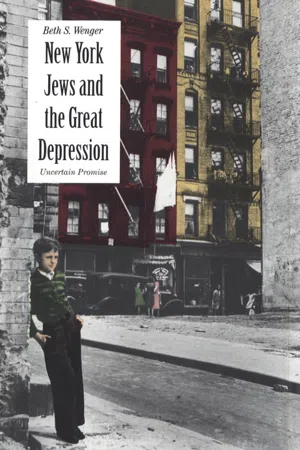
- English
- PDF
- Available on iOS & Android
New York Jews and the Great Depression
About This Book
This remarkable chronicle of New York City's Jewish families during the years of the Great Depression describes a defining moment in American Jewish history. Beth S. Wenger tells the story of a generation of immigrants and their children as they faced an uncertain future in America. Challenging the standard narrative of American Jewish upward mobility, Wenger shows that Jews of the era not only worried about financial stability and their security as a minority group, but also questioned the usefulness of their educational endeavors and the ability of their communal institutions to survive. Wenger uncovers the widespread changes throughout the Jewish community that enabled it to emerge from the turmoil of this period and become a thriving middle-class ethnic group in the post-World War II era.
Responses to the Great Depression set in motion new forms of Jewish adaptation and acculturation in the United States. Jewish families pooled their resources, says Wenger. Children remained in their parents' homes to pursue education when jobs were scarce and postponed marriage and childbearing. Jewish neighborhoods nurtured a sense of Jewish community and provided support networks for working-class families. Although the New Deal and the welfare state transformed ethnic politics, Jewish political culture remained intact and actually facilitated Jewish entry into the new Democratic coalition. Jewish leaders preserved private Jewish philanthropy in New Deal America by redesigning it as a vehicle to strengthen ethnic culture and commitment. In struggling Depression-era synagogues, Jewish leaders consciously addressed social, economic, and political needs and expanded secular and cultural activities. The changes inaugurated during the Great Depression decisively shaped the character of American Jewish life in the twentieth century.
Frequently asked questions
Information
Table of contents
- Contents
- Figures and Tables
- Acknowledgments
- Introduction
- 1 An Ethnic Economy
- 2 A Family Affair
- 3 Starting Out in the Thirties
- 4 The Landscape of Jewish Life
- 5 From Neighborhood to New Deal
- 6 Private Jewish Philanthropy in the Welfare State
- 7 The Spiritual Depression
- 8 American Jews and the American Dream
- Appendix Report of the Survey of 7,775 Applications to the Federation Employment Service from September 1934 to May 1935
- Abbreviations
- Notes
- Index